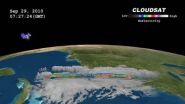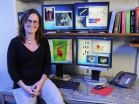(Press-News.org) NANO -- World's smallest antenna . . .
Instead of the conventional long piece of metal or dipole antenna, electronic devices of tomorrow could incorporate an antenna no bigger than a gnat. This is made possible by a design that allows an electrically charged nano-mechanical oscillator to be tuned to specific electromagnetic waves. "Gone will be the days when we need to match the antenna length to the wavelength," said Panos Datskos, a co-developer of this proprietary technology. The potentially revolutionary system detects very small electric fields over large frequency ranges while maintaining substantial power efficiency, making it ideal for environmental, homeland security and electric grid applications. Other developers are Nickolay Lavrik, Slo Rajic and Thomas Thundat. [Contact: Ron Walli, (865) 576-0226; wallira@ornl.gov]
INDUSTRY -- A real steel . . .
Wireless sensors that alert steel mill operators to abnormal temperatures and vibrations that foretell wasted energy and imminent failure are expected to pay big dividends. Through the Department of Energy's Industrial Technologies Program, Oak Ridge National Laboratory has been commissioned to install and operate wireless sensors and controls to assess the energy savings of a suite of technologies, said Wayne Manges, a program manager in ORNL's Measurement Science and Systems Engineering Division. The measurements of motors and other components will be sent by secure radio signals to plant operators and archived for energy analysis. Similar technology used in the nuclear industry is avoiding down time and providing millions of dollars in savings. The steel mills involved in this project are in Braddock, Pa., and Cayce, S.C. [Contact: Ron Walli, (865) 576-0226; wallira@ornl.gov]
COMPUTING -- Visualizing surprising beauty . . .
Expressed as raw data, a simulation performed on a supercomputer would appear as a formless sea of trillion-floating-operations-per-second calculations. But when the visualization researchers do their work, the results are often as colorful and captivating as they are revealing. Recently researchers from the computational science community gathered at the annual Scientific Discovery through Advanced Computing Program (SciDAC) conference. The visualizations of supernovae, fusion reactors and shattering projectiles help researchers gain scientific insight from their computations: http://www.ornl.gov/info/news/pulse/no321/feature.shtml. [Contact: Bill Cabage, (865) 574-4399; cabagewh@ornl.gov]
ENERGY STORAGE -- Beyond lithium ion symposium . . .
Growing interest in electric vehicles from the public, government and industry is creating a demand for scientific and technical advances in energy storage options. Experts in the field of electrochemical energy storage will bring their brainpower together at Oak Ridge National Laboratory Oct. 7-8 for a symposium called "Scalable Energy Storage Beyond Li-Ion: Materials Perspectives". A consortium of IBM Research and four DOE national labs (Argonne, Lawrence Berkeley, Oak Ridge, and Pacific Northwest) will hold talks, poster sessions and discussions to explore research opportunities in electrochemical energy storage. The ORNL conference, the third in a Beyond Lithium Ion series, will emphasize how materials science can accelerate progress in scalable energy storage. In 2009 IBM's Almaden Institute symposium was the first to address scalable energy storage, followed by Argonne National Lab's May 2010 symposium covering computational perspectives. For more information, visit the symposium website at https://www.ornl.gov/ccsd_registrations/battery/index.shtml [Contact: Morgan McCorkle, (865) 574-7308; mcccorkleml@ornl.gov]
### END
Story tips from the US Department of Energy's Oak Ridge National Laboratory October 2010
2010-10-01
ELSE PRESS RELEASES FROM THIS DATE:
Plants that move: How a New Zealand species disperses seeds in a high alpine, wet environment
2010-10-01
High in an alpine meadow, Gesine Pufal, from the University of Wellington, New Zealand, crouched low to the ground and splashed some water from her water bottle on a low green plant cushion, then sat back waiting to see if something would move. Sound crazy? Many hikers passing by her may have thought so, but Pufal was trying to find potential plant species that possess a type of plant movement called hygrochasy.
Although the ability to move is typically thought to be a characteristic unique to the animal kingdom, plants are also capable of movement, from the sudden ...
NASA satellites see Nicole become a remnant, another low soaking US East Coast
2010-10-01
Tropical Storm Nicole was a tropical storm for around 6 hours before it weakened into a remnant low pressure area and is now off the Florida coast. NASA Satellite imagery captured different views of Nicole's clouds as the system weakened back into a low pressure area.
While Nicole weakened, a huge trough of low pressure over the U.S. eastern seaboard from Florida to Maine has become the key weathermaker there. The trough, an elongated area of low pressure, is streaming tropical moisture from Nicole's remnants and the Gulf of Mexico, bringing high rainfall totals and severe ...
Women's study finds longevity means getting just enough sleep
2010-10-01
A new study, derived from novel sleep research conducted by University of California, San Diego researchers 14 years earlier, suggests that the secret to a long life may come with just enough sleep. Less than five hours a night is probably not enough; eight hours is probably too much.
A team of scientists, headed by Daniel F. Kripke, MD, professor emeritus of psychiatry at UC San Diego School of Medicine, revisited original research conducted between 1995 and 1999. In that earlier study, part of the Women's Health Initiative, Kripke and colleagues had monitored 459 women ...
IBEX finds surprising changes at solar boundary
2010-10-01
When NASA launched the Interstellar Boundary Explorer (IBEX) on October 19, 2008, space physicists held their collective breath for never-before-seen views of a collision zone far beyond the planets, roughly 10 billion miles away. That's where the solar wind, an outward rush of charged particles and magnetic fields continuously spewed by the Sun, runs into the flow of particles and fields that permeates interstellar space in our neighborhood of the Milky Way galaxy.
No spacecraft had ever imaged the collision zone, which occurs in a region known as the heliosheath, because ...
NIH scientists describe how salmonella bacteria spread in humans
2010-10-01
VIDEO:
See a time-lapse series showing hyper-replication of Salmonella bacteria (red) in epithelial cells from two to seven hours after infection.
Click here for more information.
New findings by National Institutes of Health scientists could explain how Salmonella bacteria, a common cause of food poisoning, efficiently spread in people. In a study published this week in the Proceedings of the National Academy of Sciences, researchers describe finding a reservoir of rapidly ...
Slicing proteins with Occam's Razor
2010-10-01
A cheetah lies still in the grass. Finally, a gazelle comes into view. The cheetah plunges forward, reaches sixty-five miles per hour in three seconds, and has the hapless gazelle by the jugular in less than a minute. Then it must catch its breath, resting before eating.
A blue whale surfaces, blasting water high from its blowhole. It breathes in great gasps, filling its thousand-gallon lungs with air. Then it descends again to look for krill, staying below for 10, 20, even 30 minutes before taking another breath.
Both animals need oxygen, of course. And both depend ...
Iowa State University researcher examines mosquito gene for new disease response
2010-10-01
Ames, Iowa - An Iowa State University researcher searched for new genes that are turned on during infection in a type of mosquito that is not only a pest, but transmits disease-causing pathogens.
Lyric Bartholomay, assistant professor of entomology, along with colleagues from around the world, infected the common southern house mosquito (Culex quinquefasciatus) with various pathogens to see which mosquito genes are activated in response to the infection.
Bartholomay is the first author on the paper, "Pathogenomics of Culex quinquefasciatus and Meta-Analysis of Infection ...
Short and long sleep in early pregnancy linked to high blood pressure in the third trimester
2010-10-01
DARIEN, IL – A study in the Oct. 1 issue of the journal Sleep found that getting too little or too much sleep in early pregnancy is associated with elevated blood pressure in the third trimester. The study suggests that improving prenatal sleep hygiene may provide important health benefits.
Results show that the mean systolic blood pressure in the third trimester was 114 mm Hg in women with a normal self-reported nightly sleep duration of nine hours in early pregnancy, 118.05 mm Hg in women who reported sleeping six hours or less per night, and 118.90 mm Hg in women ...
Is photoscreening the best way to catch 'lazy eye'?
2010-10-01
SAN FRANCISCO, CA– Amblyopia, known as "lazy eye," is a major cause of vision problems in children and a common cause of blindness in people aged 20 to 70 in developed countries. In amblyopia the person's stronger eye is favored and his/her weaker eye gradually loses visual power as a result. When the condition is detected and treated before age 7, more than 75 percent of children achieve 20/30 vision or better, the Amblyopia Treatment Study reports. But parents and teachers can easily miss this problem–especially in very young children. Pediatric ophthalmologists (Eye ...
Most suicidal adolescents receive follow-up care after ER visits
2010-10-01
SAN FRANCISCO – For suicidal adolescents, the emergency department (ED) is most often the chosen portal to mental health services. New research, presented Friday, Oct. 1, at the American Academy of Pediatrics (AAP) National Conference and Exhibition in San Francisco, looks at what happens to the 30 percent of suicidal adolescents who are discharged from the ED and whether they go on to access additional mental health services.
In "Predictors of Mental Health Follow up Among Adolescents with Suicidal Ideation After Emergency Department Discharge," researchers followed ...



